
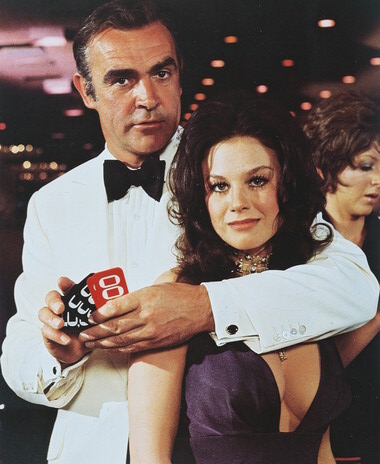 | Diamonds Are Forever
Producer: EON
Worst (and best) line: |
He Really
Does Live Twice Sean
Connery returned to the series after a one picture hiatus. George
Lazenby reportedly flew to California before Connery was signed to plead for
another chance. "I'll be better this time," he supposedly said.
Good Cut
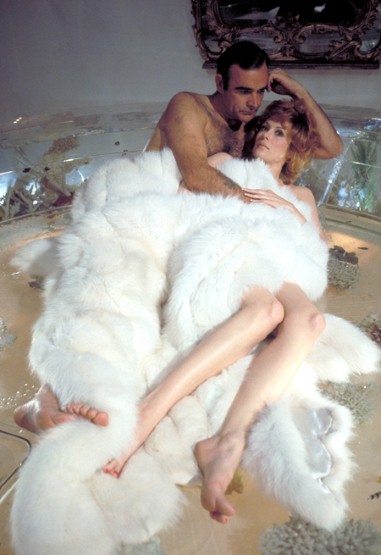 |
Bond escapes cremation at the Slumber Mortuary, stealing a hearse and driving it back to the Tropicana Hotel and Casino. Screeching to a stop near the front door, Bond rushes out of the hearse, telling the doorman to "Have whatever's inside sent up to my room."
Sammy Davis Jr. had a cameo in one of the Las Vegas scenes, at the casino playing roulette, but it was cut out in editing. It can be seen in the DVD's Deleted Scenes
Originally the ending of the film went further. Bond sees Blofeld escaping in the "bathosub" and dives into the water after him, holding on to the long string of a huge weather balloon. tying it to the bathosub, he rides it to a secluded beach in Mexico. Blofeld emerges from the sub and sees Bond hanging from the balloon, quipping, "Mary Poppins, I presume." Blofeld shoots Bond down and runs for the shore. Bond follows him into a salt mine and has a final battle with the murderer of his wife. Blofeld is thrown into a granulator, where he finally meets his death. Needless to say, this idea was dropped.
Undercover
An anonymous UA Executive: "For its annual one hundred thousand dollar fee, the Fleming estate was giving us a few nice characters, ten percent of a usable plot and a great Fleming title."
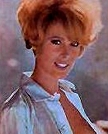 |
Director Guy Hamilton originally wanted Jane Fonda or Faye Dunaway to play Tiffany Case. Broccoli favored (as usual) Raquel Welch. But attorney Sidney Korshak asked if a small part could be had for his "close friend" Jill.
Originally, the producers wanted her for the part of Plenty O'Toole, but she worked her way up to the female lead. Dumbest moment yet in a James Bond movie: As Tiffany Case passes a slot machine in the Circus Circus casino, an elephant steps up and pulls the lever with its trunk, getting a jackpot.
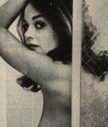 |
Originally
in the cruise ship climax, Bond discovers Wint and Kidd have bound and spread-eagled
Tiffany Case on her bed, with a vat of boiling oil suspended overhead (don't these
guys ever just shoot anybody?). Bond enters through the cabin porthole,
dumping the hot oil on Wint and tossing brandy at the flaming shish-kebabs wielded
by Kidd (as he did in the finished film).
Reportedly, the final scene Sean Connery filmed as Bond (at least in the official movie series) was the one in which an unconscious Bond is loaded into a coffin at the funeral home. So, Connery's last ever day of playing James Bond for EON Productions was Friday the 13th August, 1971.
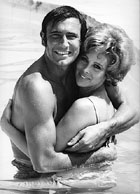 |
Diamonds Are Forever (1971) is the seventh spy film in the James Bond series by Eon Productions, and the sixth and final Eon film to star Sean Connery as the fictional MI6 agent, James Bond.
The film is based on Ian Fleming's 1956 novel of the same name, and is the second of four James Bond films directed by Guy Hamilton. The story has Bond impersonating a diamond smuggler to infiltrate a smuggling ring, and soon uncovering a plot by his old nemesis Ernst Stavro Blofeld to use the diamonds and build a giant laser. Bond has to battle his nemesis for one last time, in order to stop the smuggling and stall Blofeld's plan of destroying Washington DC, and extorting the world with nuclear supremacy.
After George Lazenby left the franchise, producers Harry Saltzman and Albert R. Broccoli tested other actors, but studio United Artists wanted Sean Connery back, paying a then-record $1.25 million salary for him to return. The producers were inspired by Goldfinger, eventually hiring that film's director, Guy Hamilton. Locations included Las Vegas, California, Amsterdam and Lufthansa's hangar in Germany. Diamonds Are Forever was a commercial success, but received criticism for its humorous camp tone.
Contents |
[edit] Plot
James Bond – agent 007 – pursues Ernst Stavro Blofeld and eventually finds him at a facility, where Blofeld look-alikes are being created through surgery. Bond kills a test subject, and later the 'real' Blofeld, by drowning him in a pool of superheated mud.
While assassins Mr. Wint and Mr. Kidd systematically kill several diamond smugglers, M suspects that South African diamonds may be being stockpiled to depress prices by dumping, and orders Bond to uncover the smuggling ring. Disguised as professional smuggler and murderer Peter Franks, Bond travels to Amsterdam to meet contact Tiffany Case. The real Franks shows up on the way, but Bond intercepts and kills him and switches IDs to make it seem like Franks is Bond. Case and Bond then go to Los Angeles, smuggling the diamonds inside Franks' corpse.
At the airport Bond meets his CIA ally Felix Leiter and goes to a funeral home, where Franks' body is cremated and the diamonds passed onto the next smuggler, Shady Tree. Bond is nearly killed by Wint and Kidd when they put him in a cremation oven, but Tree stops the process when he discovers that the diamonds in Franks' body were fakes, planted by Bond and the CIA.
Bond tells Leiter to ship the real diamonds as he goes to Las Vegas. There Bond goes to the Whyte House, a casino-hotel owned by the reclusive billionaire Willard Whyte, where Tree works as a stand-up comedian. Then Bond discovers Tree has been killed by Wint and Kidd, who did not know that the diamonds were fake. At the craps table, Bond meets the opportunistic Plenty O' Toole, and after gambling, brings her to his room. Gang members are waiting there and throw O'Toole out the window and into the pool. After they leave, Bond spends the rest of the night with Tiffany Case. Bond then tells Tiffany, who wants to steal the diamonds for herself, to retrieve the diamonds at the Circus Circus casino.
Tiffany picks up the diamonds, but reneges on her deal and flees, passing off the diamonds to the next smuggler. However, seeing that O'Toole was killed after being mistaken for her, Tiffany changes her mind and drives Bond to the airport, where the diamonds are given to Bert Saxby. Following Saxby's van, Bond eventually enters the car which drives to a remote facility. Bond enters the apparent destination of the diamonds – a research laboratory owned by Whyte, where he finds that a satellite is being built by a laser refraction specialist, Professor Dr. Metz. When Bond's cover is blown, he escapes by stealing a moon buggy and reunites with Tiffany.
Bond and Tiffany return to the Whyte House. Bond scales the walls to the top floor to confront Whyte. Inside, 007 is instead confronted by two identical Blofelds who use an electronic device to sound like Whyte. Bond kills one of the Blofelds, but it turns out to be a look-alike. He is then knocked out by gas, where he is picked up by Wint and Kidd and taken out to Las Vegas Valley where he is placed in a pipeline and left to die. After Bond escapes, he calls Blofeld posing as Saxby. He finds out Whyte's location and rescues him, but in the meantime Blofeld abducts Case. With the help of Whyte, Bond raids the lab and uncovers Blofeld's plot to create a laser satellite using the diamonds, which by now is already in orbit. With the satellite, Blofeld destroys nuclear weapons in China, the Soviet Union and the United States, then proposes an international auction for global nuclear supremacy.
Whyte identifies an oil rig off the coast of Baja California as Blofeld's base of operations. After Bond's attempt to change the cassette containing the satellite control codes fails due to a mistake by Tiffany, Leiter and the CIA begin a helicopter attack on the rig. Blofeld tries to escape on a mini-sub, but Bond gains control of it, crashing it into the control room, causing the satellite control and base to be destroyed. Bond and Tiffany then head for Britain on a cruise ship, where Bond also foils Wint and Kidd's attempt to kill them with a hidden bomb.
[edit] Cast
- Sean Connery as James Bond: MI6 agent 007.
- Jill St. John as Tiffany Case: A diamond smuggler.
- Charles Gray as Ernst Stavro Blofeld: Main antagonist, the megalomaniac head of SPECTRE. Gray had previously appeared in the Bond film series when he played Dikko Henderson in 1967's You Only Live Twice.
- Jimmy Dean as Willard Whyte: An entrepreneur, based on Howard Hughes.
- Bruce Glover as Mr. Wint and Putter Smith as Mr. Kidd: Blofeld's henchmen.
- Norman Burton as Felix Leiter: CIA agent and Bond's ally in tracking Blofeld.
- Joseph Furst as Professor Doctor Metz: A brilliant scientist and world's leading expert on laser refraction.
- Lana Wood as Plenty O'Toole: Bond's opportunistic would-be girlfriend who is thrown out the window into the hotel swimming pool.
- Bruce Cabot as Bert Saxby: Whyte's casino manager in cahoots with Blofeld.
- Bernard Lee as M: The head of MI6.
- Lois Maxwell as Miss Moneypenny: M's secretary.
- Desmond Llewelyn as Q: Head of MI6's technical department.
- Joe Robinson as Peter Franks: Diamond smuggler whose identity is taken by Bond.
- Marc Lawrence as Rodney
- Sid Haig as Slumber Inc. attendant
- Leonard Barr as Shady Tree: A Casino stand-up comedian and another smuggler.
- Laurence Naismith as Sir Donald Munger: Diamond expert who brings the case to MI6.
- David Bauer as Morton Slumber: President of Slumber Incorporated, a funeral home.
- Ed Bishop as Klaus Hergerscheimer: Health Physicist for WW Techtronics.
- David de Keyser as Doctor
- Lola Larson and Trina Parks as Bambi and Thumper
[edit] Production
The producers originally intended to have Diamonds Are Forever re-create commercially successful aspects of Goldfinger, including hiring its director, Guy Hamilton.[1] Peter R. Hunt, who had directed On Her Majesty's Secret Service and worked in all previous Bond films as editor, was invited before Hamilton, but due to involvement with another project could only work in the film if the production date was postponed, which the producers declined to do.[2]
[edit] Writing
This was the last Bond movie by Eon to use SPECTRE or Blofeld – elements that had not been featured in Ian Fleming's book, the content of which was largely eschewed in the adaptation. After this, writer Kevin McClory's legal claim against the Fleming estate that he, and not Ian Fleming, had created the organisation for the novel Thunderball was upheld by the courts. Blofeld is seen but not identified later in For Your Eyes Only (1981), as Eon's arrangements with the Fleming estate did not permit them to use McClory's works.
The original plot had as a villain Auric Goldfinger's twin, seeking revenge for the death of his brother. The plot was later changed after Albert R. Broccoli had a dream, where his close friend Howard Hughes was replaced by an imposter. So the character of Willard Whyte was created, and Tom Mankiewicz was chosen to rework the script.[3] The adaptation eliminated the main villains from the source Ian Fleming novel, mobsters called Jack and Seraffimo Spang, but used the henchmen Shady Tree, Mr. Wint and Mr. Kidd.[3]
Richard Maibaum's original idea for the ending was a giant boat chase across Lake Mead with Blofeld being pursued by Bond and all the Las Vegas casino owners who would be sailing in their private yachts. Bond would rouse the allies into action with a spoof of Lord Nelson's famous cry, "Las Vegas expects every man to do his duty." Maibaum was misinformed; there were no Roman galleys or Chinese junks in Las Vegas, and the idea was too expensive to replicate, so it was dropped.[4]
Maibaum may have thought the eventual oil rig finale a poor substitute, but it was originally intended to be much more spectacular. Armed frogmen would jump from the helicopters into the sea and attach limpet mines to the rig's legs (this explains why frogmen appear on the movie's poster). Blofeld would have escaped in his BathoSub and Bond would have pursued him hanging from a weather balloon.[5] The chase would have then continued across a salt mine with the two mortal enemies scrambling over the pure white hills of salt before Blofeld would fall to his death in a salt granulator. Permission was not granted by the owners of the salt mine. It also made the sequence too long. Further problems followed when the explosives set up for the finale were set off too early; fortunately, a handful of cameras were ready and able to capture the footage.[4]
[edit] Casting
 |
Charles Gray was cast as master villain Ernst Stavro Blofeld, after playing a Bond ally called Henderson in You Only Live Twice (1967).[1] David Bauer who plays Morton Slumber previously appeared uncredited as an American diplomat also in You Only Live Twice.
Jazz musician Putter Smith was invited by Harry Saltzman to play Mr. Kidd after a Thelonious Monk Band show. Musician Paul Williams was originally cast as Mr. Wint. But when he couldn't agree with the producers on compensation, Bruce Glover replaced him. Glover said he was surprised at being chosen, because at first producers said he was too normal and that they wanted a deformed, Peter Lorre-like actor.[1] During a late 1990's airing of the movie on TBS's Dinner and A Movie, Bruce Glover recalled that while filming their scenes together, he and Putter Smith had Sean Connery convinced that the two were actually openly homosexual. Glover added that a few years later while on an airline flight he was flirting with a female flight attendant, and suddenly heard a Sottish accented voice saying "You son of a bitch..." Glover turned around and saw the man was Connery.
Film star Bruce Cabot, who played the part of Bert Saxby, died the following year and this turned out to be his final film role. Jimmy Dean was cast as Willard Whyte after Saltzman saw a presentation of him. Dean was very worried about playing a Howard Hughes pastiche, because he was an employee of Hughes at the Desert Inn.[1]
Actresses considered for the role of Tiffany Case included: Raquel Welch, Jane Fonda and Faye Dunaway. Jill St. John had originally been offered the part of Plenty O'Toole but landed the female lead after impressing director Guy Hamilton during screen tests. St. John became the first American Bond girl.[10] Lana Wood was cast as Plenty O'Toole following a suggestion of screenwriter Tom Mankiewicz.[1] The woman in the bikini named "Marie", who in the beginning of the film is convinced by Bond to give up the location of Blofeld, was Denise Perrier, Miss World 1953.[3]
[edit] Filming
Filming began on 5 April 1971, with the South African scenes actually shot in the desert near Las Vegas, and finished in 13 August 1971.[1] The film was shot primarily in the US, with locations including the Los Angeles International Airport,[11] Universal City Studios and eight hotels of Las Vegas.[12] Besides the Pinewood Studios in Buckinghamshire, other places in England were Dover and Southampton. The climactic oil rig sequence was shot off the shore of Oceanside, California. Other filming locations included Cap D'Antibes in France for the opening scenes, Amsterdam and Lufthansa's hangar in Germany.[13]
Filming in Las Vegas took place mostly in hotels owned by Howard Hughes, since he was a friend of Cubby Broccoli.[10] Getting the streets empty in order to shoot was achieved through the collaboration of Hughes, the Las Vegas police and shopkeepers association.[4] The Las Vegas Hilton doubled for the Whyte House, and since the owner of the Circus Circus was a Bond fan, he allowed the Circus to be used on film and even made a cameo.[3][4] The cinematographers said filming in Las Vegas at night had an advantage: no additional illumination was required due to the high number of neon lights.[14] Sean Connery made the most of his time on location in Las Vegas. "I didn't get any sleep at all. We shot every night, I caught all the shows and played golf all day. On the weekend I collapsed – boy, did I collapse. Like a skull with legs." He also played the slot machines, and once delayed a scene because he was collecting his winnings.[15]
The site used for the Willard Whyte Space Labs (where Bond gets away in the Moon Buggy) was actually, at that time, a Johns-Manville gypsum plant located just outside of Las Vegas. The home of Kirk Douglas was used for the scene in Tiffany's house, while the Elrod House in Palm Springs, designed by John Lautner, became Willard Whyte's house.[16] The exterior shots of the Slumber mortuary were of a real crematorium on the outskirts of Las Vegas. The interiors were a set constructed at Pinewood Studios, where Ken Adam imitated the real building's lozenge-shaped stained glass window in its nave. During location filming, Adam visited several funeral homes in the Las Vegas area, the inspiration behind the gaudy design of the Slumber mortuary (the use of tasteless Art Deco furniture and Tiffany lamps) came from these experiences.[13] Production wrapped with the crematorium sequence, on 13 August 1971.[3]
Since the car chase in Las Vegas would have many car crashes, the filmmakers had an arrangement with Ford to use their vehicles. Ford's only demand was that Sean Connery had to drive the 1971 Mustang Mach 1 which serves as Tiffany Case's car.[4] The Moon Buggy was inspired by the actual NASA vehicle, but with additions such as flaying arms since the producers didn't find the design "outrageous" enough. Built by custom car fabricator Dean Jeffries on a rear-engined Corvair chassis, it was capable of road speeds. The fibreglass tires had to be replaced during the chase sequence because the heat and irregular desert soil ruined them.[17]
Hamilton had the idea of making a fight scene inside a lift, which was choreographed and done by Sean Connery and stuntman Joe Robinson.[18] The car chase where the red Mustang comes outside of the narrow street on the opposite side in which it was rolled, was filmed over three nights on Fremont Street in Las Vegas. The alleyway car roll sequence is actually filmed in two locations. The entrance was at the car park at Universal Studios and the exit was at Fremont Street, Las Vegas. It eventually inspired a continuity mistake, as the car enters the alley on the right side tires and exits the street driving on the left side.[1][19] While filming the scene of finding Plenty OęToole drowned in Tiffany's swimming pool, Lana Wood actually had her feet loosely tied to a cement block on the bottom. Film crew members held a rope across the pool for her, with which she could lift her face out of the water to breathe between takes. The pool's sloping bottom made the block slip into deeper water with each take. Eventually, Wood was submerged but was noticed by on-lookers and rescued before drowning for real. Wood, being a certified diver, took some water but remained calm during the ordeal, although she later admitted to a few "very uncomfortable moments and quite some struggling until they pulled me out."[20]
[edit] Music
"Diamonds Are Forever", the title song, was the second James Bond theme to be performed by Shirley Bassey, after "Goldfinger" in 1964. Producer Harry Saltzman reportedly hated the song, and only the insistence of co-producer Cubby Broccoli kept it in the film. Saltzman's major objection was to the sexual innuendo of the lyrics. Indeed, in an interview for the television programme James Bond's Greatest Hits composer John Barry revealed that he told Bassey to imagine she was singing about a penis. The song has been extensively covered or sampled. It has been covered by David McAlmont and can be heard on David Arnold's Bond song compilation album, "Shaken and Stirred: The David Arnold James Bond Project". It was also covered by the Arctic Monkeys at the 2007 Glastonbury Festival. It has been sampled in the song "Sexy Lady" by Yung Berg and "Diamonds from Sierra Leone" by Kanye West. The song has also been used on the song "Psychology" by Dead Prez. Bassey would later return for a third performance for 1979's Moonraker.
The original soundtrack was once again composed by John Barry, his sixth time composing for a Bond film.
With Connery back in the lead role, the "James Bond Theme" was played by an electric guitar in the somewhat unique, blued gunbarrel sequence accompanied with prismatic ripples of light, and pre-credits sequence, and in a full orchestral version during a hovercraft sequence in Amsterdam.
[edit] Release and reception
Diamonds are Forever was released on 14 December 1971. It grossed $116 million worldwide,[21] of which $43 million was from the United States.[22]
Reviews were mixed, as the camp tone had a mostly negative reaction, the film currently carrying a 64% rating at Rotten Tomatoes.[23] Connery was applauded by Kevin A. Ranson of MovieCrypt and Michael A. Smith of Nolan's Pop Culture. Critic Roger Ebert criticised the complexity of the plot and "moments of silliness" such as Bond finding himself driving a moon buggy with antennae revolving and robot arms flapping. He praised the Las Vegas car chase scene, particularly the segment when Bond drives the Mustang on two wheels.[24] Twenty-five years after its release James Berardinelli criticised the concept of a laser-shooting satellite and the performances of Jill St. John, Norman Burton and Jimmy Dean.[25] Christopher Null called St. John "one of the least effective Bond girls – beautiful, but shrill and helpless".[26] Steve Rhodes said, "looking and acting like a couple of pseudo-country bumpkins, they (Putter Smith and Bruce Glover) seem to have wandered by accident from the adjoining sound stage into the filming of this movie." But he also extolled the car chase as "classic".[27] According to Danny Peary, Diamonds are Forever is "one of the most forgettable movies of the entire Bond series" and that "until Blofeld’s reappearance we must watch what is no better than a mundane diamond-smuggling melodrama, without the spectacle we associate with James Bond: the Las Vegas setting isn’t exotic enough, there’s little humour, assassins Mr. Kidd and Mr. Wint are similar to characters you’d find on The Avengers, but not nearly as amusing – and the trouble Bond gets into, even Maxwell Smart could escape.”[28]
IGN chose it as the third worst James Bond film, behind only The Man with the Golden Gun and Die Another Day,[29] while Norman Wilner of MSN chose it as the sixth worst.[30] Total Film listed Mr. Wint and Mr. Kidd, and Bambie and Thumper, as the first and second worst villains in the Bond series (respectively).[31]
The film was nominated for an Academy Award for Best Sound (Gordon McCallum, John W. Mitchell and Al Overton)[32] but lost to Fiddler on the Roof.[33]
[edit] References
- ^ a b c d e f g h i ‹The template Cite video is being considered for deletion.› (NTSC, Widescreen, Closed-captioned) Inside Diamonds Are Forever: Diamonds Are Forever Ultimate Edition, Disc 2 (DVD). MGM/UA Home Video. 2000. ASIN: B000LY2L1Q.
- ^ Interview with Peter R. Hunt. Retrovision. 1997. http://web.archive.org/web/20090214005715/http://retrovisionmag.com/jamesbond.htm.
- ^ a b c d e ‹The template Cite video is being considered for deletion.› John Cork. Commentary track: Diamonds Are Forever Ultimate Edition, Region 4 (DVD). MGM Home Entertainment.
- ^ a b c d e ‹The template Cite video is being considered for deletion.› Guy Hamilton. Commentary track: Diamonds Are Forever Ultimate Edition, Region 4 (DVD). MGM Home Entertainment.
- ^ ‹The template Cite video is being considered for deletion.› Oil Rig Attack: Diamonds Are Forever Ultimate Edition, Disc 2 (DVD). MGM Home Entertainment.
- ^ ‹The template Cite video is being considered for deletion.› Inside On Her Majesty's Secret Service (DVD). OHMSS Ultimate Edition DVD: MGM Home Entertainment Inc. 2000.
- ^ David Walliams takes some acting tips from Michael Gambon, The Sunday Times
- ^ UK CPI inflation numbers based on data available from Lawrence H. Officer (2010) "What Were the UK Earnings and Prices Then?" MeasuringWorth.
- ^ Feeney Callan, Michael (2002). Sean Connery. Virgin Books. p. 217. ISBN 1-85227-992-3.
- ^ a b Diamonds Are Forever Ultimate Edition DVD (Album notes). MGM/UA Home Video. ASIN: B000LY2L1Q. http://www.jamesbondondvd.com/booklets/diamonds/.
- ^ "Los Angeles". Postcard Destinations. 7 January 2008. 8 minutes in. Voyager Channel.
- ^ ‹The template Cite video is being considered for deletion.› (PAL) Exotic Locations: Diamonds Are Forever Ultimate Edition, Disc 2 (DVD). MGM Home Entertainment. ASIN: B00004VUHC.
- ^ a b ‹The template Cite video is being considered for deletion.› (NTSC, Widescreen, Closed-captioned) Exotic Locations: Diamonds Are Forever Ultimate Edition, Disc 2. ASIN: B000LY2L1Q.
- ^ ‹The template Cite video is being considered for deletion.› Peter Lamont. Commentary track: Diamonds Are Forever Ultimate Edition, Region 4 (DVD). MGM Home Entertainment.
- ^ "Rare interview with Sean Connery on the set of Diamonds Are Forever in Las Vegas". MI6-HQ.com. http://www.mi6-hq.com/sections/articles/history_press_daf_sean_connery_las_vegas_interview.php3. Retrieved 30 March 2011.
- ^ Decorating: Diamonds are Forever – archive: HGTV
- ^ ‹The template Cite video is being considered for deletion.› Ken Adam. Commentary track: Diamonds Are Forever Ultimate Edition, Region 4 (DVD). MGM Home Entertainment.
- ^ ‹The template Cite video is being considered for deletion.› Double-O Stuntmen. The Man with the Golden Gun Ultimate Edition, Disk 2: MGM Home Entertainment.
- ^ "Diamonds Are Forever". Turner Classic Movies. http://www.tcm.com/thismonth/article.jsp?cid=235282&mainArticleId=235259. Retrieved 25 January 2011.
- ^ ‹The template Cite video is being considered for deletion.› Lana Wood. Commentary track: Diamonds Are Forever Ultimate Edition, Region 4 (DVD). MGM Home Entertainment.
- ^ "Diamonds Are Forever". TheNumbers. http://the-numbers.com/movies/1971/0DAFE.php. Retrieved 24 December 2007.
- ^ "Diamonds Are Forever". Box Office Mojo. http://www.boxofficemojo.com/movies/?id=diamondsareforever.htm. Retrieved 9 December 2007.
- ^ "Diamonds Are Forever". Rotten Tomatoes. http://www.rottentomatoes.com/m/diamonds_are_forever/. Retrieved 3 March 2010.
- ^ Roger Ebert (1 December 1971). "Diamond Are Forever review". Chicago Sun-Times. http://rogerebert.suntimes.com/apps/pbcs.dll/article?AID=/19710101/REVIEWS/101010306/1023. Retrieved 24 December 2007.
- ^ Berardinelli, James (1996). "Diamonds Are Forever: A film review". Reelviews.net. http://www.reelviews.net/movies/d/diamonds.html. Retrieved 5 February 2008.
- ^ Null, Christopher. "Diamonds are Forever". Filmcritic.com. http://www.filmcritic.com/misc/emporium.nsf/reviews/Diamonds-Are-Forever. Retrieved 5 February 2008.
- ^ Rhodes, Steve (1998). "Diamonds are Forever". IMDb Reviews. http://www.imdb.com/Reviews/110/11069. Retrieved 5 February 2008.
- ^ Danny Peary, Guide for the Film Fanatic (Simon & Schuster, 1986) p.123
- ^ "James Bond's Top 20". IGN. 17 November 2006. http://movies.ign.com/articles/746/746573p1.html. Retrieved 21 December 2007.
- ^ Norman Wilner. "Rating the Spy Game". MSN. http://movies.sympatico.msn.ca/features/ArticleNormanWilner.aspx?cp-documentid=436189. Retrieved 21 December 2007.
- ^ Chris Hicks (13 October 2008). "Bond Month: The crappest Bond villians (sic) of all time". Total Film. http://www.totalfilm.com/features/bond-month-the-crappest-bond-villians-of-all-time. Retrieved 15 October 2008.
- ^ "The 44th Academy Awards (1972) Nominees and Winners". oscars.org. http://www.oscars.org/awards/academyawards/legacy/ceremony/44th-winners.html. Retrieved 27 August 2011.
- ^ "Academy Awards Database". AMPAS. http://awardsdatabase.oscars.org/ampas_awards/BasicSearch?action=searchLink&displayType=1&BSCategoryExact=1618&BSFromYear=44. Retrieved 6 February 2011.
| Films, main | The Seventies |
